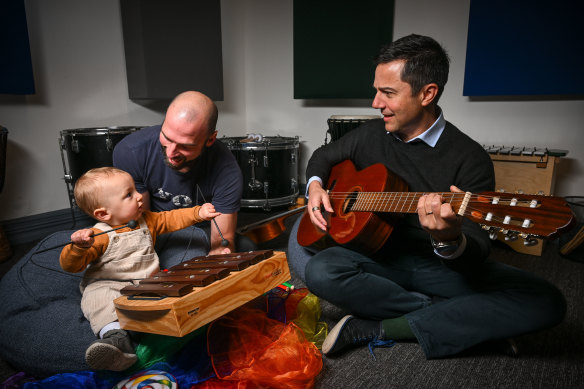Music to our ears: How rhythm can help kids with language

Save articles for later
Add articles to your saved list and come back to them any time.
It may sound like a simple rhythm, but researchers say music could hold the key to a child’s language development.
Regular musical rhythms have been found to help children with speech and language-processing difficulties, and those without them.
Music therapist Jason Kenner (right) with one-year-old Jasper and his father, Shem Le Scelle.Credit: Eddie Jim
A study conducted at the Lyon Neuroscience Research Centre in France, and published this month, tested 15 children with developmental language disorder and 18 without language-processing difficulties.
Cognitive psychologist Dr Anna Fiveash, from Western Sydney University and a co-author of the study, said the children listened to words played in regular rhythms for 30 seconds, then in irregular rhythms in which a beat wasn’t clear.
When asked to repeat sets of sentences as accurately as possible, those listening to the regular rhythms showed remarkable results.
“We found that across all of the children – including those with language problems – the sentences were better able to be repeated out loud after the children had heard the regular musical rhythms compared to the irregular musical rhythms,” Fiveash said.
Fiveash said researchers found regular rhythm could boost a child’s sentence repetition. Children with developmental language disorder had difficulty doing that out loud, especially when the sentences were complex.
The study could have applications in classroom settings and for parents, who could play music with their young children to help with language acquisition and understanding complex sentences.
Fiveash said music rhythm was predictable and structured, so children could tell what was coming next.
“Language has rhythm as well, but it’s not as predictable, right? So the idea with these kinds of studies is that you can use this predictability of the rhythm to then, kind of, move over to the language domain,” she said.
“Music and language share some similar brain areas.”
Fiveash said that when children learn to speak, it could be difficult to tell when one word started and another began. Musical rhythm could help with this.
“The idea is quite hard to test in the younger children because, you know, they’re still developing language, but I think across all ages, really, it would be a beneficial thing,” she said.
Co-author Dr Enikő Ladányi, from Vanderbilt University Medical Centre in Tennessee, said the study – Regular rhythmic primes improve sentence repetition in children with developmental language disorder – shed light on neurodevelopmental disorders and could help with speech therapy guidelines and practices.
Kat McFerran, a professor of music therapy at the University of Melbourne, said any tasks which helped students settle and be calm and focused before taking on a complex task were helpful.
“Rhythm provides a more natural avenue for helping in that way, without the distraction of lyrics and with a simple beat,” she said.
But McFerran believed students needed to listen via headphones and pay particular attention, for the rhythms to be effective with language.
Registered music therapist Jason Kenner said people not only listened to music with their ears, but with their muscles and brains.
“It affects your memory,” Kenner said.
“It’s very human. The brain is really interesting, it’s multi-modal, and it’s when you are connecting different brain processes together – the effectiveness of learning – it gets better, it’s faster, it’s more permanent.
“A study like this is good because it builds evidence that shows the connections in our brain when we use rhythm to do an activity, are important.”
Shem Le Scelle, the father of one-year-old Jasper, agreed that rhythm cadence really helped a child with any sort of language.
“You look at it when you speak to any child, speaking in songs with rhythm and rhyming can help them pick up language better,” he said.
“My kid, Jasper, definitely responds to language spoken in rhythm better than any other form of delivery.”
The Morning Edition newsletter is our guide to the day’s most important and interesting stories, analysis and insights. Sign up here.
Most Viewed in National
From our partners
Source: Read Full Article
